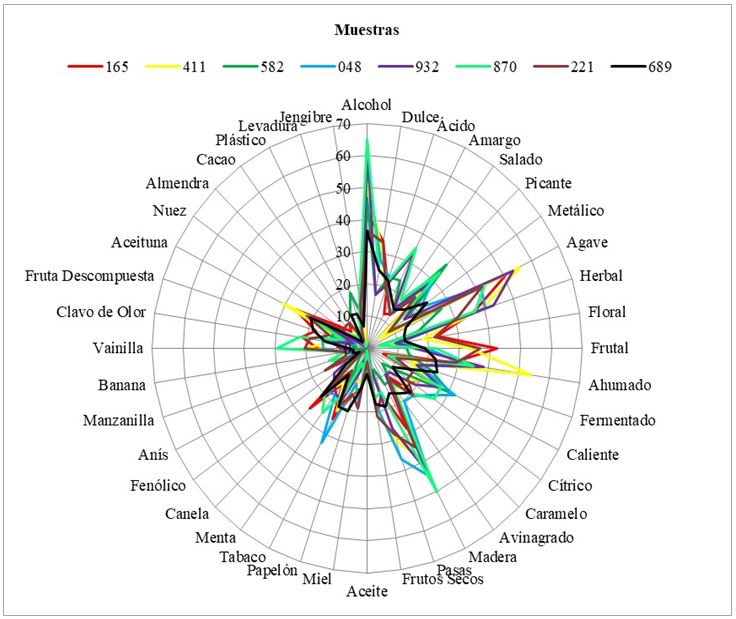Organoleptic profile of the Cocuy de Penca produced in Lara Venezuela
DOI:
https://doi.org/10.13140/RG.2.2.15486.95044Keywords:
Agave Cocuy Trelease, organoleptic profile, VenezuelaAbstract
Cocuy de penca is an indigenous alcoholic beverage of the Venezuelan territory, produced from the Agave Cocui Trelease plant and considered as natural, ancestral and cultural heritage of the nation, being a distillate that has gained relevance in the market in recent years due to their particular sensory characteristics. The purpose of the research was to establish the organoleptic properties of the Cocuy de Penca produced in Lara. For this, eight samples from different parishes were selected; subsequently, the study had the following order: definition of the sensory descriptors, construction of the survey, selection of the panel of juries, conditioning of the environment for the tasting, preparation of the samples and, finally, sensory analysis. Obtaining that the organoleptic profile of the samples of Cocuy larense make it up two descriptors for visual analysis, twenty for olfactory and eighteen for gustatory.
Downloads
References
Ministerio del Poder Popular para la Salud, Providencia administrativa número 266-2017, 2017.
D. W. Lachenmeier y J. Rehm. Is there a relationship between alcohol quality and health?, Alcohol and alcoholism, 48(1):127-129, 2012.
C. A. Reeves y D. A. Bednar. Defining quality: alternatives and implications. Academy of management Review, 19(3):419-445, 1994.
S. T. Lund y J. Bohlmann. The molecular basis for wine grape quality-a volatile subject. Science, 311(5762):804-805, 2006.
M. Gutiérrez, A. Llobera, J. Vila-Planas, F. Capdevila, S. Demming, S. Büttgenbach y C. Jiménez-Jorquera. Hybrid electronic tongue based on optical and electrochemical microsensors for quality control of wine. Analyst, 135(7):1718-1725, 2010.
J. Chick, J. Gill, C. Tsang y H. Black. Too white, too cheap, too fast: is health damage caused by alcohol partly attributable to low cost which permits rapid consumption of beverages lacking antioxidants?. Alcohol and Alcoholism, 46(1):i25-i26, 2011.
P. J. Gruenewald, W. R. Ponicki, H. D. Holder y A. Romelsjö. Alcohol prices, beverage quality, and the demand for alcohol: quality substitutions and price elasticities. Alcoholism: Clinical and Experimental Research, 30(1):96-105, 2006.
M. B. D. Miranda, N. G. S. Martins, A. E. D. S. Belluco, J. Horii y A. R. Alcarde. Chemical quality of Brazilian sugarcane spirits. Food Science and Technology, 27(4):897-901, 2007.
D. W. Lachenmeier, F. Kanteres y J. Rehm. Is it possible to distinguish vodka by taste? Comment on structurability: a collective measure of the structural differences in vodkas. Journal of agricultural and food chemistry, 59(1):464-465, 2010.
L. Daniel, F. Pedrero y R. M. Pangborn. Evaluación sensorial de los alimentos. Métodos analíticos, México DF: Longman de México Editores, S.A. de C.V., 1997.
S. Badui Dergal. Química de los alimentos, México: Pearson Educación, 2006.
S. Maza. Rum aroma descriptive analysis. LSU Master's Theses, Louisiana State University and Agricultural and Mechanical College, 2002.
H. M. Liebich, W. A. Koenig y E. Bayer. Analysis of the flavor of rum by gas-liquid chromatography and mass spectrometry. Journal of Chromatographic Science, 8(9):527-533, 1970.
I. González-Robles, M. Estarron-Espinoza, H. Escalona-Buendia, E. Herrera-López y D. Díaz-Montaño. Perfiles aromáticos y sensoriales de tequilas obtenidos por levaduras del género kloeckera y saccharomyces en cultivos puros y mixtos. II National Congress of Biotechnology and Sustainable Agricultural Production, Agosto 2010.
O. Gómez-Zamora, K. De Jesús-Fuentes, F. Peñafiel-López y P. Tovar-Hernández. Perfil químico y organoléptico de los compuestos volátiles del Mezcal. Investigación y Desarrollo en Ciencia y Tecnología de Alimentos, 1(1):916-923, 2016.
M. D. De Souza, P. Vásquez, N. L. del Mastro, T. E. Acree y E. H. Lavin. Characterization of cachaça and rum aroma. Journal of agricultural and food chemistry, 54(2):485-488, 2006.
K. Mathias-Rettig y K. Ah-Hen. El color en los alimentos un criterio de calidad medible. Agro sur, 42(2):57-66, 2014.
S. Oliveira, D. D. de Sousa Fernandes y G. Véras. Overview of analytical techniques associated with pattern recognition methods in sugarcane spirits samples. Critical Reviews in analytical chemistry, 49(6):477-487. 2019.
I. L. Granadillo, G. T. Rodríguez, R. H. Motzezak y H. M. Guillén. Efecto de la temperatura y el pH en la fermentación del mosto de Agave cocui. Multiciencias, 14(4):375-381, 2014.
M. C. Leal de Pérez, E. E. Pérez Camacho, H. A. Morán Guillén, H. J. R. Motzezak, O. Pérez Ones y A. García López. Vapor liquid equilibrium of musts of Agave cocui in a constant pressure. Revista Técnica de la Facultad de Ingeniería Universidad del Zulia, 40(3):152-160, 2017.
F. Arias. El Proyecto de investigación, Sexta ed., Caracas: Editorial Episteme C.A., 2012.
L. M. Alvarez Ainza, A. García Galaz, H. González Ríos, N. Prado Jaramillo y E. Acedo-Félix. Sensory analysis and minor volatil compounds of distilled from Agave angustifolia Haw (Bacanora), Biotecnia, 17(3):22-29, 2015.

Published
How to Cite
Issue
Section
Copyright (c) 2020 Carla Fajardo de Andara

This work is licensed under a Creative Commons Attribution-NonCommercial-ShareAlike 4.0 International License.
The opinions expressed by the authors do not necessarily reflect the position of the publisher of the publication or of UCLA. The total or partial reproduction of the texts published here is authorized, as long as the complete source and the electronic address of this journal are cited.
The authors fully retain the rights to their works, giving the journal the right to be the first publication where the article is presented. The authors have the right to use their articles for any purpose as long as it is done for non-profit. Authors are recommended to disseminate their articles in the final version, after publication in this journal, in the electronic media of the institutions to which they are affiliated or personal digital media.


